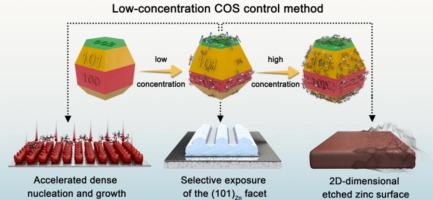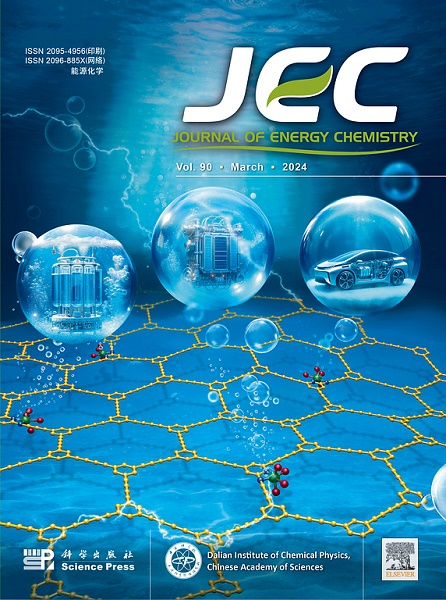微量 COS 诱导的 (101)Zn 面暴露锌电极的沉积和蚀刻,实现锌电池的超长循环稳定性
IF 13.1
1区 化学
Q1 Energy
引用次数: 0
摘要
由于锌沉积和蚀刻过程的不稳定性,可充电锌基水溶液电池(RZB)的循环稳定性通常较差。这项研究通过在 ZnSO4 电解液(2 g L-1 COS)中添加微量壳聚糖低聚糖(COS)的 "三重调节策略",实现了无树枝状晶核的锌沉积,且成核半径更小,成核阶段快速完成。理论和实验结果表明,带有羟基和氨基官能团的 COS 对 (002)Zn 和 (100)Zn 面具有很高的亲和力。在少量 COS 的影响下,(101)Zn 面的选择性暴露得到了促进。广泛暴露的 (101)Zn 面受到 COS 的保护,从而抑制了副反应的发生。此外,痕量 COS-02 的存在将蚀刻模式从三维(3D)转变为二维(2D),确保了在沉积过程中 Zn2+ 在电场中的均匀分布。COS 添加剂诱导的独特三维沉积和二维蚀刻机制带来了卓越的循环稳定性,在锌对称电池中超过 3800 小时(1 mA cm-2)和 430 小时(5 mA cm-2)。此外,COS 还是稳定 VS2 的 "分子支柱",使 Zn||VS2 全电池实现了 1000 次稳定循环,容量保持率达到 89.6%,平均库仑效率达到 99.95%。这项工作揭示了在 RZB 中使用痕量 COS 的新型多重调节机制,为开发具有优先暴露面的长期稳定 RZB 提供了一种新方法。本文章由计算机程序翻译,如有差异,请以英文原文为准。

Deposition and etching of (101)Zn facet exposed zinc electrode induced by trace COS achieving ultra-long cycle stability in zinc batteries
Rechargeable aqueous zinc-based batteries (RZBs) often suffer from poor cycling stability due to the instability of zinc deposition and etching processes. This work achieves dendrite-free zinc deposition with a smaller nucleation radius and rapid completion of the nucleation stage by a “triple regulation strategy” with trace chitosan oligosaccharide (COS) in ZnSO4 electrolyte (2 g L−1 COS). Theoretical and experimental results indicate that COS, with hydroxyl and amino functional groups, exhibits a high affinity for the (002)Zn and (100)Zn facets. Under the influence of a small amount of COS, the selective exposure of the (101)Zn facet is facilitated. The extensively exposed (101)Zn facet is protected by COS, which inhibits the occurrence of side reactions. Moreover, the presence of trace COS-02 changes the etching mode from three-dimensional (3D) to two-dimensional (2D), ensuring a uniform distribution of Zn2+ in the electric field during the deposition process. The unique 3D deposition and 2D etching mechanism induced by the COS additive result in exceptional cycling stability, exceeding 3800 h (1 mA cm−2) and 430 h (5 mA cm−2) in zinc symmetrical cells. Additionally, COS acts as a “molecular pillar” to stabilize VS2, enabling the Zn||VS2 full cell to achieve 1000 stable cycles with 89.6% capacity retention and an average coulombic efficiency of 99.95%. This work reveals a novel multiple regulation mechanism by using trace COS in RZBs, and provides a new approach for the development of long-term stable RZBs with preferential exposure facets.
求助全文
通过发布文献求助,成功后即可免费获取论文全文。
去求助
来源期刊

Journal of Energy Chemistry
CHEMISTRY, APPLIED-CHEMISTRY, PHYSICAL
CiteScore
19.10
自引率
8.40%
发文量
3631
审稿时长
15 days
期刊介绍:
The Journal of Energy Chemistry, the official publication of Science Press and the Dalian Institute of Chemical Physics, Chinese Academy of Sciences, serves as a platform for reporting creative research and innovative applications in energy chemistry. It mainly reports on creative researches and innovative applications of chemical conversions of fossil energy, carbon dioxide, electrochemical energy and hydrogen energy, as well as the conversions of biomass and solar energy related with chemical issues to promote academic exchanges in the field of energy chemistry and to accelerate the exploration, research and development of energy science and technologies.
This journal focuses on original research papers covering various topics within energy chemistry worldwide, including:
Optimized utilization of fossil energy
Hydrogen energy
Conversion and storage of electrochemical energy
Capture, storage, and chemical conversion of carbon dioxide
Materials and nanotechnologies for energy conversion and storage
Chemistry in biomass conversion
Chemistry in the utilization of solar energy
 求助内容:
求助内容: 应助结果提醒方式:
应助结果提醒方式:


